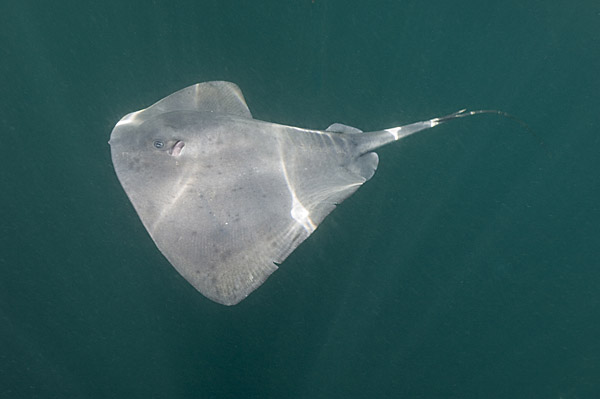View all available
Pelagic Stingray Pictures in the
Shark Pictures Database
Common English Names: Pelagic stingray,
Violet stingray, Blue stingray,
Guilers stingray.
Latin Name:
Dasyatis violacea.
Note: some scientists consider the pelagic stingray to be distinct enough to
warrant its own genus. Hence it is also listed as Pteroplatytrygon violacea.
Family:
Dasyatidae.
Identification:
Romboid disc (kite shaped) with broadly rounded
anterior margin. Posterior marging of disc much straighter and tapering towards
tail. Tail very long with long ventral finfold. Dorsal finfold absent. One long
tail sting usually visible. Dorsum lavender, violet or dark purple. Ventrum also
light or dark violet. In individuals with lighter coloration ventrum may darken
towards margin. Eyes flush with disc i.e. not protruding.
Size:
Maximum disc width about 80cm.
Habitat:
surface to 381m.
A wide ranging pelagic species (probably the only one among the dasyatid rays)
that may be found on the substrate or free swimming in open water.
Abundance and distribution:
The pelagic stingray is probably circumglobal
in tropical and warmer subtropical and temperate seas. In Eastern Atlantic there
are scattered reports from the southern Mediterranean, Cape Verde, to Southern
Africa. In eastern Pacific from California, throughout Baja and Galapagos. Also
Chile.
Diet:
Coelenterates (jellyfish and medusae),
crustaceans, oceanic squid and fishes. Occasionally caught on long-lines baited
with mackeral in the Sea of Cortez.
Behavior:
The Pelagic stingray swims in the open ocean
unlike most whiptail stingrays. It also feeds on the bottom.
Reproduction:
Ovoviviparous.
Photographs:
Sea of Cortez, La Paz, Baja, Mexico.
Similar species:
Many whiptail stingrays have overlapping ranges
with the Pelagic or Violet stingray. Most can be distinguished by their more
sedentary lifestyle. Physical identification is best based on violet coloration
and non protruding eyes of the Pelagic stingray; both unusual characteristics.
Reaction to divers:
Quickly swims away.
Diving logistics:
The Pelagic stingray is very rarely encountered by divers. The images shown
here were taken of a specimen that was released by artesanal longline shark
fishermen.
Reports of Pelagic stingray sightings would be very welcome:
email elasmodiver
Other diving locations submitted by readers:
Other names
for the Pelagic stingray:
紫魟
China Main
Mandarin Chinese
黑魟
China Main
Chinese
吉勒氏魟
China Main
Chinese
Τρυγόνα
Greece
Greek
Μούντριζα
Greece
Greek
Μούτρουβα
Greece
Greek
Blue stingray
Azores Is.
English
Boll tork
Malta
Maltese
Boll vjola
Malta
Maltese
Bugghiu niru
Italy
Italian
Escurçana violeta
Spain
Catalan
Ferrassa neigra
Italy
Italian
Ferrazza
Italy
Italian
Γλαυκοτρυγόνα
Greece
Greek
Glafkotrygona
Greece
Greek
Guilers stingray
Australia
English
Hurchje
Italy
Italian
Ignelivatoz
Turkey
Turkish
K'ak'ew'
Can Br Colum
Salish
Karasu-ei
Japan
Japanese
Muchio spinoso
Italy
Italian
Ogoncza pelagicza
Poland
Polish
Ogończa pelagiczna
Poland
Polish
Pastenague violette
France
French
Pastinaca violacea
Italy
Italian
Peitschenrochen
Germany
German
Pelagiese pylstert
Namibia
Afrikaans
Pelagisk pigrokke
Denmark
Danish
Pilrokke
Norway
Norwegian
Pilskate
Norway
Norwegian
Prelato
Italy
Italian
Protene
Italy
Italian
Pylstert
Namibia
Afrikaans
Raya látigo pelágica
Mexico
Spanish
Raya-látigo violeta
Galapagos Is.
Spanish
Σαλάχι
Greece
Greek
Sálahi trygéna
Greece
Greek
Siba zutulja
SerbiaMontenegro
Serbian
Sinikeihäsrausku
Finland
Finnish
Stechrochen
Germany
German
Trigone viola
Italy
Italian
Trigone violetto
Malta
Italian
Trigono
Italy
Italian
Trnucha pelagická
Czech Rep
Czech
Uge-violeta
Portugal
Portuguese
Vastunaca spinosa
Italy
Italian
Violet stingray
English
Violett spjutrocha
Sweden
Swedish
Violett Spjutrocka
Sweden
Swedish
Violette pijlstaartrog
Netherlands
Dutch
Violetter Stechrochen
Germany
German
Volina
SerbiaMontenegro
Serbian
Vurchie
Italy
Italian






















